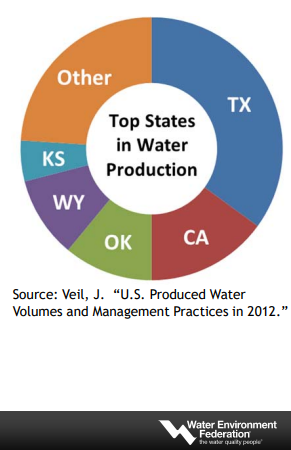Water as a Product
Oil has been around for many decades, while natural gas followed closely after. What a lot of people don't know about natural gas, is at one point, it was considered a waste product from oil production until both became a worldwide commodity.
Since natural gas is now considered a valuable resource along with oil, does produced water from these operations also become a valuable resource?

(Life Cycle of Produced Water with Regulatory Issues: Jill E. Cooper, JD. Slide 30)
With companies racing to invent new technology and applications for produced water management, the cost is a key consideration when implementing the best wastewater management system.
Produced Water is generally found in most producing oil and natural gas wells in the US. In 2007, produced water management systems were used primarily for injection for EOR, injection for disposal, and surface discharge.1
It wasn't until 2012 that other produced water management systems were utilized in the market. Evaporation, offsite commercial disposal, and beneficial reuse are all areas that companies are exploring to find the best solution for their specific oil and gas operation.

(Life Cycle of Produced Water with Regulatory Issues: Jill E. Cooper, JD. Slide 31)
Opportunities for Produced Water as a solution
Water sourcing, management, and disposal are all areas in which produced water can be used. Opportunities to collaborate with other contractors and businesses are becoming a norm.
The actions necessary to maximize these opportunities are innovations in water treatment technologies, reduced cost of water treatment, entities interested in accepting treated water, and laws and regulations that support beneficial reuse.1
Produced Water industry trends
Industry trends include a variety of benefits. Trends such as improving fracturing chemistry to increase the use of non-fresh water, innovations in treatment technology to increase the feasibility of produced water reuse, and increasing water conveyance systems to reduce truck traffic2 are exploding in popularity to reduce high costs and maintain high productivity.
Dedicated water staff is also becoming more necessary to improve water management, plan technical support, and maintain performance. Plug-and-play technology that allows workers to manage their water systems remotely, and in real-time, is considered to be a game changer in this industry.
Top States in Water Production

(Life Cycle of Produced Water with Regulatory Issues: Jill E. Cooper, JD. Slide 35)
With every state having its own set of requirements, regulations, and permits, it is important for companies to follow the rules to a T. In some cases, awaiting approval from permits could take anywhere from a week to a year.
You can learn more about the Florida Senate Bill 64 - Reclaimed Water and how it affects wastewater facilities by clicking on the link here.
Permits are needed for discharge to the surface, as well as permits that may be needed if provided to another user. Permits are not usually necessary for the use of produced water or the reuse of flowback water.1
Oil and Gas Water Services by Sector and Region
The oil and gas water service sector has dramatically increased from 2014 to 2020. It went from $37,888m in 2014 to $53,790m in 2020.2
Water disposal services and water hauling services are dominating this sector while produced water treatment services and produced water treatment equipment following close after.
The region using these water services the most is North America, with the Middle East, North Africa, and East Asia representing roughly 25% of the services.2

(PW Management: Market & Treatment. Hossain M. Azam. F. Morris Hoagland. Slide 46)
Conclusion
The Produced Water Management and Service sectors are constantly growing. As new technologies and solutions are created to keep up with the high demand for oil and gas production around the world, people will start to generate higher returns on investments while being environmentally safe.
To learn more about how evaporation could be a vital component of your oil and gas Produced Water operations, check out Evaporation Works evaporator page to find the most enhanced evaporation technology for your specific operation.
Resources:
- Jill E. Cooper, JD. (2019, April 25). Fundamentals of Produced Water Treatment in the Oil and Gas Industry. Life Cycle of Produced Water with Regulatory Issues (Slides 30-32, 35). Upstream O&G Subcommittee of Industrial Wastewater Committee (IWWC). WEF with Produced Water Society (PWS). https://www.wef.org/events/webcasts/upcoming-webcasts/2019-webcasts/FundamentalsProducedWater/
- Hossain M. Azam, Ph.D., F. Morris Hoagland, PE. (2019, April 25). Fundamentals of Produced Water Treatment in the Oil and Gas Industry. PW Management: Market & Treatment (Slides 46). Upstream O&G Subcommittee of Industrial Wastewater Committee (IWWC). WEF with Produced Water Society (PWS). https://www.wef.org/events/webcasts/upcoming-webcasts/2019-webcasts/FundamentalsProducedWater/



